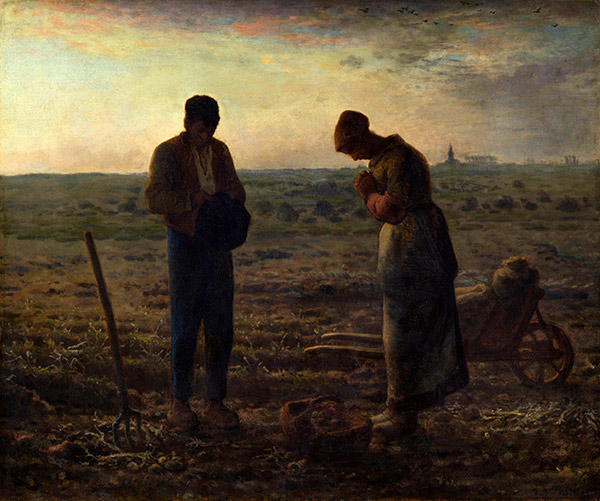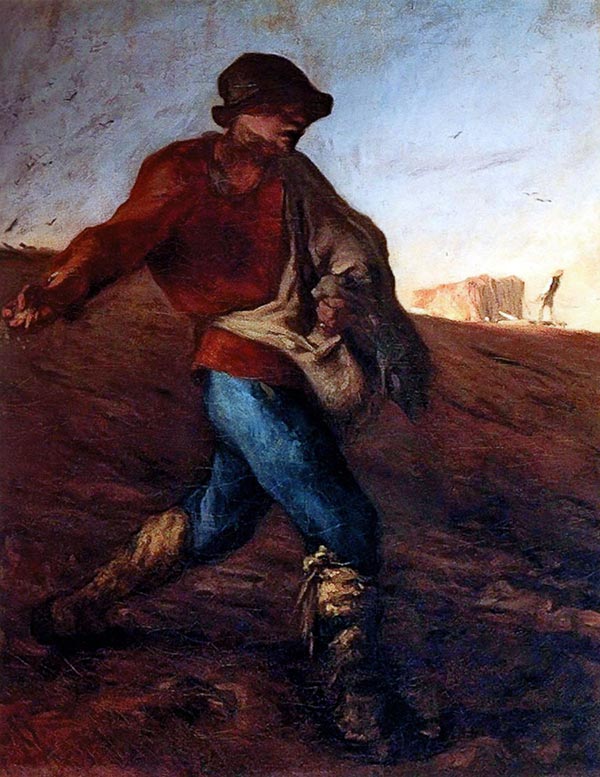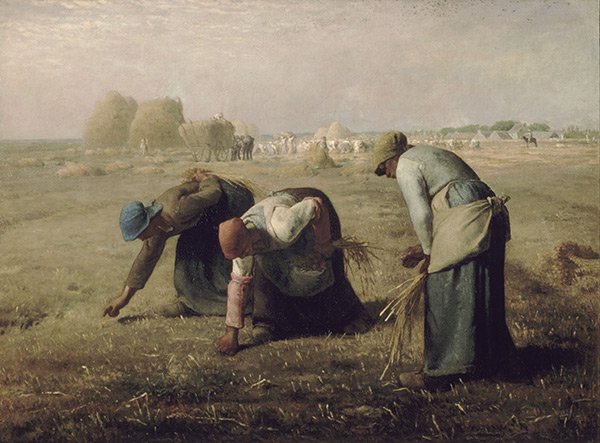Subtotal: $
Checkout
To Plow His Furrow in Peace
Jean-François Millet’s art taps his peasant roots to honor the dignity of rural life.
By Nathan Beacom
May 12, 2021
Available languages: español
You might’ve seen it hanging in some grandma’s living room. This little painting, The Angelus, shows a couple stopping to pray during their farm chores in the evening. It’s got the stuff grandmas tend to love: farming, warmth, soft colors, and praying. When it was first displayed in Paris in 1857, though, this painting really upset people. Like many paintings by Jean-Francois Millet, this one angered wealthy art types who objected to the way it glorified poor peasants. Art was for depicting dignified things, like lords and ladies and historical events and Greek myths and things like that. It was not for poor people.
But Millet was one of those poor country people, and he loved the place where he grew up. In time, his ability to portray those things with both honesty and affection would outlast the privileged critics of his work, and he would change the way French society thought about the marginalized rural worker.
Jean-François Millet got his artistic eye from his father. Though the elder Millet put his hand to plows and not paintbrushes, he was always receptive to the beauty around him; during chores, he would present to his son a blade of grass or the curve of a hillside with the words “see how fine . . . how beautiful!”
The “François” in the boy’s name was in honor of Francis of Assisi, and would presage his love for birds, fields, and all parts of nature. The name was given him by his grandmother, whose sense of the Catholic faith was deeply tied to a connection with nature, in which she saw most clearly the hand of God. It was a way of faith, Millet said, that allowed her to love “deeply and unselfishly,” to eschew judging others, and to give to the needy.
François, as he was usually called, grew up sensitive to both beauty and its absence. If he possessed a special openness to the splendor of nature and of human goodness, he had also a certain vulnerability to what Alfred Sensier, his biographer and friend, called man’s “ignorance of all that is good and generous.” In other words, he had an eye for the world’s brokenness as much as its wholeness.
“I saw that he who had done this was capable, with a single figure, to personify the good or evil of all humanity.”
In addition to the example of his own father, it was from the poet Virgil that Millet learned to honor rural life. Reading the Georgics and Bucolics, where Virgil sings songs, not just of gods and great figures, but of plowmen and shepherds, revealed the sacredness in ordinary rural work. “His only ambition,” wrote Sensier, “was to accomplish his duties as a son, to plow his furrow in peace.”
One day, on the way home from church, Millet was struck by the bent-over form of an old farmer; suddenly he understood at once the rules of perspective and foreshortening, and hurried home to put what he had seen to paper. His parents immediately laughed as they recognized their neighbor in the depiction. As Millet attempted a few more pictures, it became apparent that his was no ordinary knack for drawing; he expressed to his father a desire to learn the painter’s trade. François’s father was struck by his son’s gift, which no one had known about prior to this first drawing at age nineteen. He apologized in a heartfelt way to François for keeping him at the farm instead of developing his talent. But now, with the younger boys growing up and able to contribute to farm work, he was eager to find François a teacher.
Not long after Millet went to learn how to paint from his first teacher, a fellow lover of the country named Bon DuMouchel, he was drawn back home by his father’s bad health. Suffering from a “brain fever,” Millet’s father could not hear or speak to his son. Millet attempted to pick up the pieces, running the family farm, but again, those who loved him pushed him to return to art. In time, Millet went to Cherbourg, where his teacher, Théophile Langlois de Chèvreville, was so impressed by his skill that he persuaded the city council simply to pay him a yearly salary as an artist-in-residence. In time, that funding ran out and it became clear that if Millet was to progress, he must go to Paris.

Jean-Francois Millet, The Angelus
In Paris, Millet went to the Royal Museum to meet a kindly instructor named Monsieur Georges, with whom he had mutual friends in Cherbourg. Georges, impressed by Millet’s paintings, showed them to the other instructors and students, who exclaimed in surprise, “We didn’t know they could do that out in the provinces!” Millet was invited to study at the museum, but the sense of competition and ambition there pushed him away. That, he thought, was not what art was about.
Although the young Millet approached Paris with some skepticism, he was enthralled by the Louvre, which he had desired so long to see. In it, spending day after day with the works of the old masters, he was hit deep by the capacity of great art to move him and to allow him to feel the feelings of others. “Sometimes the sorrows of St. Sebastian seemed to go right through me,” he said. “The masters of that time are magnetic; they give the joys and sorrows that trouble them; they are incomparable. I saw a drawing of Michelangelo’s . . . the figure weighed down by physical suffering gave me a succession of feelings. I was tormented by pain, I pitied him, I suffered with that very body, those very limbs. I saw that he who had done this was capable, with a single figure, to personify the good or evil of all humanity.”
Millet had an aversion to anything theatrical, desiring what was natural, real, and fully human. One can see this already in his early painting, with its honesty and closeness to life – real life, with its textures and irregularities. He could not stand art that objectified or depersonalized women, and admired instead painters like Titian and Rubens, whose women were “strong . . . and so sure of their power.” Human beauty, for him, was chiefly in the expression of the body and of the face, whereby the character of the soul is made manifest. Just as he refused the theatrical, he rejected anything sentimental and overly delicate. He desired an art based in truth.
At the studios and museums of Paris, artists and laymen would look on this burly, bearded country person (whom his fellow students named “man of the woods”) as a bit dim and slow. Although Millet was very well-read, perceptive, and a fine translator of Latin, he had the reticence sometimes known in folks from deep in the country. His quietness was taken for stupidity, and he was considered an ignorant yokel. When city people would talk what seemed like nonsense in front of him, he would only grow obstinately more silent in reply, and they would in turn only think him more stupid.
After a brief marriage to Pauline-Virginie Ono, which ended in her illness and early death, Millet married a girl from Cherbourg named Catherine Lemaire, and together they settled in Paris. There they were always poor. An uncertain art market and the chaos of revolutionary activity left the couple scraping by. Millet painted what would sell: portraits, classical scenes, revolutionary paintings, and so on; he was desperate to feed his family.
All subjects are good, he said, if painted with strength and clarity, and the artist can see most clearly and paint most strongly when he is acquainted with pain and suffering. Still, the subjects he was painting now were not close to his heart. One day, passing a shop where his paintings were being sold, he heard someone remark that these works must be by Millet, the fellow who was always painting naked women. Though not fully accurate, those words sent a pang through Millet’s artistic conscience, and he hurried back to his wife. If she would agree, he said, he wanted only to paint what was true from now on, not what society wanted. It would be hard, he told her; they would be poorer than ever. With great bravery and generosity, Catherine answered, “I am ready, do as you will.” On this day, Millet turned to what he really loved, that good subject that called out for the artist who could show its goodness with clarity and strength: his home.

Jean-Francois Millet, The Sower
In 1849, revolution and a cholera epidemic gave Millet reason to flee Paris. It had always felt a bit like a prison. He needed to be there to sell his art, but he longed for home fields, home things, and a space for his family. Although it was under sad conditions, he rejoiced at rejoining those things at last, and moved his family to the little village of Barbizon.
His impact around this time began to be felt abroad, and one contemporary American critic identified his work with “a religious reverence for humanity.” Americans at large took to his work, and paintings like The Sower and The Angelus can still be seen in rural living rooms today. In France, these paintings came to stand for republican or socialist values, a rebuke to the rich and an endorsement of the glory of the laborer. The image of the sower became an icon for populists of all kinds for a century. Even today, a figure echoing The Sower crowns the soaring tower of the Nebraska State Capital.
Millet had no interest in politics and did not care for his art to be made into propaganda. He did, though, have an interest in humanity, and in showing the sacredness to be found in ordinary life. Sympathetic French critics identified the power in his paintings as growing out of love of place and of people. “He was neither a socialist nor an idealist,” Sensier wrote, “but like all deep thinkers, he loved humanity; he suffered with its woes, and longed to express them. For this, he only needed to paint the peasant at his work. In spite of himself, and without knowing it, he entered into the heart of the question.”
“Some tell me that I deny the charms of the country. I find much more than charms – I find infinite glories.”
Still, his rustic paintings met with a great deal of negativity from critics and Parisian society. The truthfulness with which they depicted rural people and rural life was labeled mere ugliness. At the same time, it could not be denied that in the honesty of these depictions, a truth perceived through eyes of love, the figures of shepherdesses and weed pickers and farmers were glorified. That bothered the critics too. They were shocked that a grand painting of monumental beauty, like The Gleaners, would be dedicated not to anyone noble or heroic but to three country women. In The Calf they sensed irreverence. Why were the men in the picture carrying this little calf like it was something divine? To this Millet retorted, “How else would you have them carry it?”
To those who called his art ugly, he responded with what Sensier called his credo:
Some tell me that I deny the charms of the country. I find much more than charms – I find infinite glories. I see as well as they do the halos of dandelions, and the sun, also, which spreads out beyond the world its glory in the clouds. But I see as well, in the plain, the steaming horses at work, and in a rocky place a man, all worn out whose [grunt] has been heard since morning, and who tries to straighten himself a moment and breathe. The drama is surrounded by beauty.
No matter what political or social valence people attached to these works, whether to champion or to denounce, none could deny that Millet had captured something human. He had forced in front of the eyes of France the poor laborers of the country, those who lived out of the way and were forgotten, and the image shocked them. Urban people were made to reckon with rural humanity, and rural people found solace in seeing their way of life depicted as noble.
In spite of the critics, Millet finally began to triumph at the end of his life. In the 1860s and ’70s he began to accumulate large contracts that finally lifted his family out of poverty, and the public at large embraced his work. But as his success grew, his health failed, and he passed away in 1875, at the age of sixty. He would become the hero of Vincent van Gogh and an inspiration to Claude Monet. Even his critics had to admit that Millet “was always seeking the essential, and he found it”; that he “strove with indomitable energy to be faithful to the truth.” To this day, his works remain a reminder of the worthiness of the ordinary worker who lives an ordinary life.

Jean-Francois Millet, The Gleaners
Already a subscriber? Sign in
Try 3 months of unlimited access. Start your FREE TRIAL today. Cancel anytime.







Mark Lama
What an exceptional article! I enjoyed very much learning about Millet. His understanding of his artistic vocation seems to echo some of the best, most progressive Christian thought of his time about humanity and creation.
burl self
A truly inspiring story.
Richard Leep
What a beautiful article how this artist saw God's beauty and love through His rural people working! Loved this!
Tony
Read this this morning . Sharing in case of interest .....
Warren Wilson
Somehow I missed all of this great analysis when I studied art many decades ago. What treasures of Western Civilization!